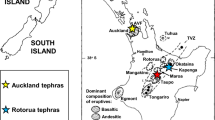Abstract
Surficial and bulk samples of historical bricks of different age (from XII to XVIII centuries) recovered from a campaign of archaeological excavations recently carried out at the site of a medieval monastery in the S. Giacomo in Paludo Island in theVenice Lagoon have been characterised by FT-IR, TGA-DTG and DTA, XRD, SEM + EDS. The samples belong to a particular brick type commonly used in the Venice region: the "altinella brick". The bulk relative abundance of primary (i.e. calcite and dolomite) and secondary firing minerals (i.e. diopside and wollastonite) in the bricks coupled with their relative geometrical dimensions allows placing the samples in a chronological sequence according to known historical changes in brickmaking firing temperatures and practices. Most of the bricks were used as paving material and have been exposed to the action of seawater salts (chlorides and sulphates) due to periodical submersion following high tide episodes. Salt-laden (gypsum, halite, mirabilite) surficial patinas are indeed present but salt weathering does not appear to have affected the overall structural soundness of the bricks in this now abandoned island as it is the case with brickwork located in other more populated (and polluted) areas in Venice and its lagoon.









Similar content being viewed by others
References
Antonelli F, Cancelliere S, Lazzarini L (2002) Minero-petrographic characterisation of historic bricks in the Arsenale, Venice. J Cult Herit 3:59–64
Baer NS, Fitz S, Livingston RA (1998) Conservation of historic brick structures. Donhead Publishing Ltd, Shaftesbury, UK
Bauluz B, Mayayo MJ, Yuste A, Fernandez-Nieto C (2004) TEM study of mineral transformations in fired carbonated clays: relevance to brick making. Clay Miner 39(n3):333–344
Bertolin A, Frizzo P, Rampazzo G (1995) Sulphide speciation in surface sediments of the Lagoon of Venice: a geochemical and mineralogical study. Mar Geol 123:73–86
Brimblecombe P, Grossi CM (2007) Damage to buildings from future climate and pollution. Am Preserv Technol Bull 38:13–19
Calliari I, Canal E, Cavazzoni S, Lazzarini L (2001) Roman bricks from the Lagoon of Venice: a chemical characterization with methods of multivariate analysis. J Cult Herit 2:23–29
Cultrone G, Rodriguez-Navarro C, Sebastian E, Cazalla O, De LaTorre MJ (2001) Carbonate and silicate phase reactions during ceramic firing. Eur J Mineral 13:621–634
Curtis CD, Spears DA (1968) The formation of sedimentary iron minerals. Econ Geol 63:257–270
Fazio G, Hreglich S, Lazzarini L, Pirredda U, Verità M (1982) Le altinelle a Venezia: problemi storici, caratterizzazione chimico-fisica, cause di deterioramento (The Venice altinelle: historical notes, chemical and physical characterization, decay causes). In: Proceedings of “Il Mattone a Venezia”, Venice, pp 367–372
Frizzo P, Rampazzo G, Molinaroli E (1991) Authigenic iron sulphides in recent sediments of the Venice Lagoon (Northern Italy). E J Mineral 3:603–612
Gatto P, Carbognin L (1987) The Lagoon of Venice: natural environmental trend and man-induced modifications. Hydrol Sci Bull 26:379–391
Gelichi S, Baudo F, Beltrame C, Calaon D, D’Agostino M (2004) Archeologia e monasteri nella laguna veneziana: S. Giacomo in Paludo (archaeology and monasteries in the Venice Lagoon: S.Giacomo in Paludo), All’Insegna del Giglio, Florence
Grossi CM, Brimblecombe P, Harris I (2007) Climate change and frost impact on the built heritage. Sci Total Environ 377:273–281
Jobstraibizer P, Malesani P (1973) I sedimenti dei fiumi veneti. Memorie della Società Geologica Italiana XII:411–452
Klenz Larsen P (2007) The salt decay of medieval bricks at a vault in Brarup Church, Denmark. Environ Geol 52:375–383
Maggetti M (1982) Phase analysis and its significance for technology and origin. In: Olin JS, Franklin AD (eds) Archaeological ceramics. Smithsonian Institution Press, Washington, pp 121–132
Maniatis Y, Simopoulus A, Kostikas A (1981) Moessbauer study of the effect of calcium content on iron oxide transformations in fired clays. J Am Ceram Soc 64–65:263–269
Price CA, Brimblecombe P (1994) Preventing salt damage in porous materials. In: Preventive conservation, theory, practice and research. Preprints of the contribution to the Ottawa Congress, IIC, vol 1009, pp 90–93
Pye K, Dickson JAD, Schiavon N, Coleman ML, Cox M (1990) Formation of siderite-Mg-calcite.-iron sulphide concretions in intertidal marsh and sandflat sediments, north Norfolk, England. Sedimentology 37:325–343
Rye OS (1976) Keeping your temper under control: materials and manufacture of Papuan pottery. Archaeol Phy Anthropol Oceania 11:106–137
Rodriguez-Navarro C, Doehne E (1999) Salt weathering: influence of evaporation rate, supersaturation and crystallization pattern. Earth Surf Process Landf 24:191–209
Sabbioni C, Bonazza A, Zappia G (2002) Damage on hydraulic mortars: the Venice Arsenal. J Cult Herit 3:83–88
Sabbioni C, Cassar M, Brimblecombe P, Tidblad R, Kozlowski R, Drdàcky M, Saiz-Jimenez C, Grontoft T, Wainwright I, Arino X (2006) Global climate change on built heritage and cultural landscapes. In: Fort R, Alvarez de Buergo M, Gomez-Heras M, Vazquez-Calvo C (eds) Heritage weathering and conservation. Taylor & Francis Group, London, pp 395–401
Schiavon N, Zhou LP (1996) Magnetic, chemical and microscopical characterization of urban soiling on historical monuments. Environ Sci Technol 30(12):3624–3629
Varosio F (2001) Mensiocronologia dei laterizi a Venezia: ricerche, verifiche di applicabilità, stesura di una prima curva (Mensiochronology of Venice bricks: research and applications). Archeologia dell’Architettura VI:1–2
Wolf S (2002) Estimation of the production parameters of very large medieval bricks from S. Urban, Switzerland. Archaeometry 44(1):37–65
Zaggia L, Zonta R (1997) Metal sulphide formation in the contaminated anoxic sludge of the Venice canals. Appl Geochem 12:527–536
Author information
Authors and Affiliations
Corresponding author
Rights and permissions
About this article
Cite this article
Schiavon, N., Mazzocchin, G.A. & Baudo, F. Chemical and mineralogical characterisation of weathered historical bricks from the Venice lagoonal environment. Environ Geol 56, 767–775 (2008). https://doi.org/10.1007/s00254-008-1481-z
Received:
Accepted:
Published:
Issue Date:
DOI: https://doi.org/10.1007/s00254-008-1481-z




